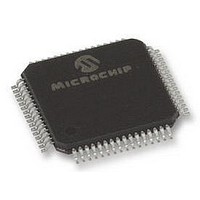DSPIC30F5011-30I/PTG Microchip Technology, DSPIC30F5011-30I/PTG Datasheet - Page 149

DSPIC30F5011-30I/PTG
Manufacturer Part Number
DSPIC30F5011-30I/PTG
Description
16BIT MCU-DSP 30MHZ, SMD, 30F5011
Manufacturer
Microchip Technology
Series
DsPIC30Fr
Datasheet
1.DSPIC30F5011-30IPTG.pdf
(220 pages)
Specifications of DSPIC30F5011-30I/PTG
Core Frequency
30MHz
Embedded Interface Type
CAN, I2C, SPI, UART
No. Of I/o's
52
Flash Memory Size
66KB
Supply Voltage Range
2.5V To 5.5V
Operating Temperature Range
-40°C To
Lead Free Status / RoHS Status
Lead free / RoHS Compliant
- Current page: 149 of 220
- Download datasheet (4Mb)
Any interrupt that is individually enabled (using the cor-
responding IE bit) and meets the prevailing priority level
will be able to wake-up the processor. The processor will
process the interrupt and branch to the ISR. The Sleep
status bit in the RCON register is set upon wake-up.
All Resets will wake-up the processor from Sleep
mode. Any Reset, other than POR, will set the Sleep
status bit. In a POR, the Sleep bit is cleared.
If the Watchdog Timer is enabled, then the processor
will wake-up from Sleep mode upon WDT time-out. The
Sleep and WDTO status bits are both set.
20.6.2
In Idle mode, the clock to the CPU is shutdown while
peripherals keep running. Unlike Sleep mode, the clock
source remains active.
Several peripherals have a control bit in each module
that allows them to operate during Idle.
LPRC Fail-Safe Clock remains active if clock failure
detect is enabled.
The processor wakes up from Idle if at least one of the
following conditions has occurred:
• any interrupt that is individually enabled (IE bit is
• any Reset (POR, BOR, MCLR)
• WDT time-out
Upon wake-up from Idle mode, the clock is re-applied
to the CPU and instruction execution begins immedi-
ately, starting with the instruction following the PWRSAV
instruction.
2004 Microchip Technology Inc.
Note:
‘1’) and meets the required priority level
In spite of various delays applied (T
T
(and PLL) may not be active at the end of
the time-out (e.g., for low frequency crys-
tals). In such cases, if FSCM is enabled,
then the device will detect this as a clock
failure and process the clock failure trap, the
FRC oscillator will be enabled and the user
will have to re-enable the crystal oscillator. If
FSCM is not enabled, then the device will
simply suspend execution of code until the
clock is stable and will remain in Sleep until
the oscillator clock has started.
IDLE MODE
LOCK
and T
PWRT
), the crystal oscillator
POR
Preliminary
,
Any interrupt that is individually enabled (using IE bit)
and meets the prevailing priority level will be able to
wake-up the processor. The processor will process the
interrupt and branch to the ISR. The Idle status bit in
the RCON register is set upon wake-up.
Any Reset other than POR will set the Idle status bit.
On a POR, the Idle bit is cleared.
If Watchdog Timer is enabled, then the processor will
wake-up from Idle mode upon WDT time-out. The Idle
and WDTO status bits are both set.
Unlike wake-up from Sleep, there are no time delays
involved in wake-up from Idle.
20.7
The configuration bits in each device configuration reg-
ister specify some of the Device modes and are
programmed by a device programmer, or by using the
In-Circuit Serial Programming™ (ICSP™) feature of
the device. Each device configuration register is a
24-bit register, but only the lower 16 bits of each regis-
ter are used to hold configuration data. There are four
device configuration registers available to the user:
1.
2.
3.
4.
The placement of the configuration bits is automatically
handled when you select the device in your device pro-
grammer. The desired state of the configuration bits
may be specified in the source code (dependent on the
language tool used), or through the programming inter-
face. After the device has been programmed, the appli-
cation software may read the configuration bit values
through the table read instructions. For additional infor-
mation, please refer to the Programming Specifications
of the device.
Note:
dsPIC30F5011/5013
F
Register
FWDT (0xF80002): Watchdog Timer
Configuration Register
FBORPOR (0xF80004): BOR and POR
Configuration Register
FGS (0xF8000A): General Code Segment
Configuration Register
OSC
Device Configuration Registers
(0xF80000): Oscillator Configuration
If the code protection configuration fuse
bits (FGS<GCP> and FGS<GWRP>)
have been programmed, an erase of the
entire code-protected device is only
possible at voltages V
DD
DS70116C-page 147
4.5V.
Related parts for DSPIC30F5011-30I/PTG
Image
Part Number
Description
Manufacturer
Datasheet
Request
R

Part Number:
Description:
IC DSPIC MCU/DSP 66K 64TQFP
Manufacturer:
Microchip Technology
Datasheet:

Part Number:
Description:
IC,DSP,16-BIT,CMOS,TQFP,64PIN,PLASTIC
Manufacturer:
Microchip Technology
Datasheet:

Part Number:
Description:
IC DSPIC MCU/DSP 66K 64TQFP
Manufacturer:
Microchip Technology
Datasheet:

Part Number:
Description:
High-Performance Digital Signal Controllers
Manufacturer:
MICROCHIP [Microchip Technology]
Datasheet:

Part Number:
Description:
IC, DSC, 16BIT, 66KB, 40MHZ 5.5V TQFP-64
Manufacturer:
Microchip Technology
Datasheet:

Part Number:
Description:
Digital Signal Processors & Controllers - DSP, DSC 16 Bit MCU/DSP 64LD 20M 66KB FL
Manufacturer:
Microchip Technology

Part Number:
Description:
IC DSPIC MCU/DSP 66K 64TQFP
Manufacturer:
Microchip Technology
Datasheet:

Part Number:
Description:
Dspic30f5011/5013 High-performance Digital Signal Controllers
Manufacturer:
Microchip Technology Inc.
Datasheet:

Part Number:
Description:
Manufacturer:
Microchip Technology Inc.
Datasheet:

Part Number:
Description:
Manufacturer:
Microchip Technology Inc.
Datasheet:

Part Number:
Description:
Manufacturer:
Microchip Technology Inc.
Datasheet:

Part Number:
Description:
Manufacturer:
Microchip Technology Inc.
Datasheet:










